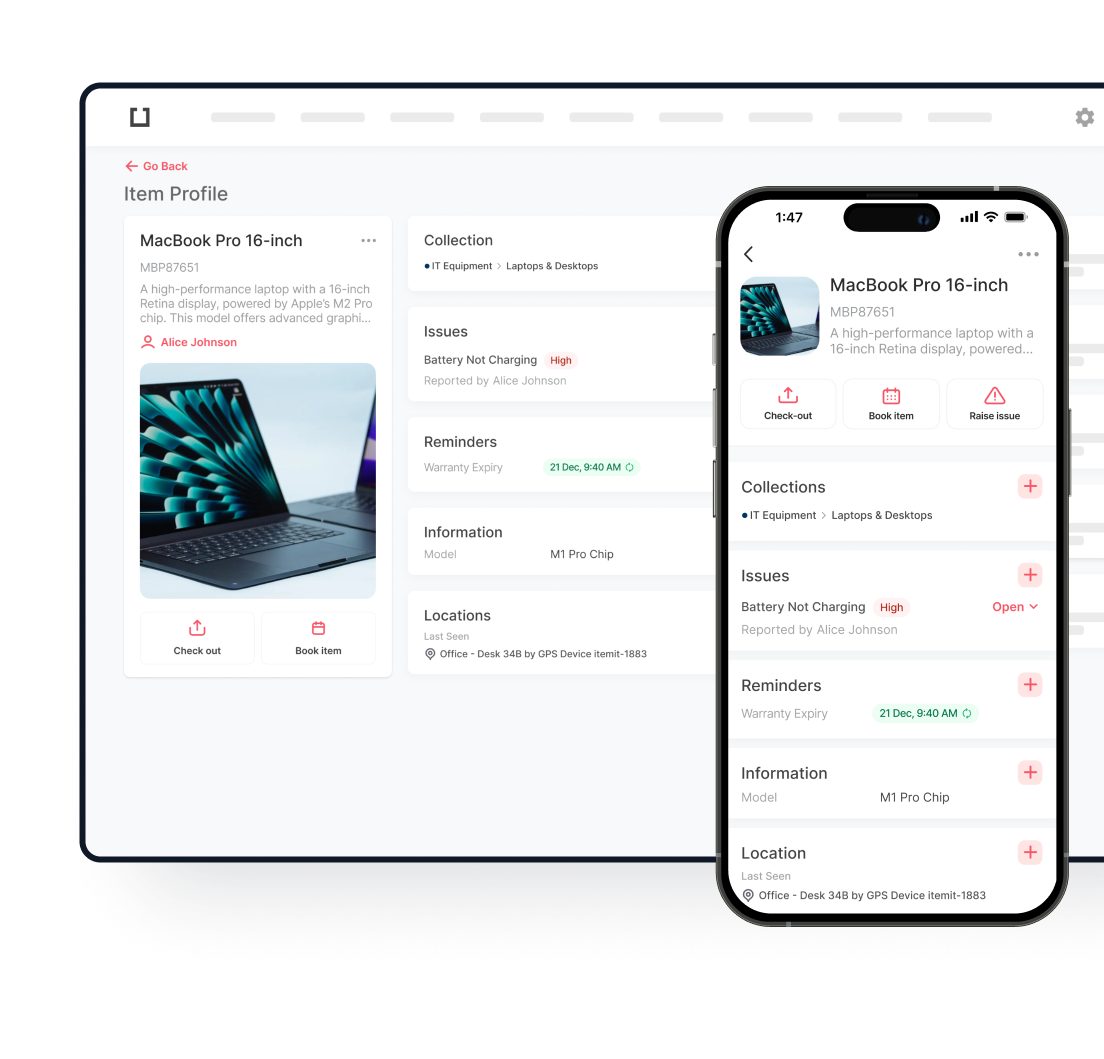
Fixed asset tagging is a way of looking after your things. Your business will have multiple fixed assets, permanent fixtures that make you money, and these need to be tracked and maintained to keep your business running.
How does fixed asset tagging help? It shows you all asset use, movement, location, and maintenance data. This data helps with transparency, responsibility, and accountability, overall creating more clarity for any decision-making processes.
What is an Asset Tag?
An asset tag is a unique identifier attached to physical items, such as equipment, tools, or technology, to facilitate tracking and management. These tags typically contain a barcode, QR code, or RFID chip, which can be scanned to access detailed information about the asset, including its location, status, and maintenance history. Asset tags for equipment are essential for businesses that need to manage a large inventory of assets, ensuring that each item is accounted for and easily traceable.
There are several types of asset tags, including:
- Barcode Tags: These are the most common type, using a simple visual code that can be scanned to pull up asset data.
- RFID Tags: These tags use radio frequency to transmit data, enabling contactless scanning, even at a distance.
- QR Code Tags: A modern option that encodes more information than a traditional barcode and can be easily scanned with a smartphone or scanner.
- Durable Tags: Designed to withstand harsh environments, these are made from materials that resist wear and tear, making them ideal for outdoor or industrial equipment.
Incorporating an asset tag system helps you organize and streamline operations by reducing the risk of lost or misplaced items and improving overall efficiency. By assigning asset tags for equipment, companies can ensure that critical data about their assets is always up to date. This will help with everything from inventory audits to compliance reporting.
What is Fixed Asset Tagging?
Fixed asset tagging is how you link your fixed assets to an online fixed asset register. This means that all of your physical fixed assets can be viewed and edited in an online profile, app, or web portal.
A fixed asset tag is a physical tag that you stick onto your fixed asset. This way, whenever an asset is scanned, the asset’s location is tracked and automatically updated in the system.
With fixed asset tagging, you can scan a QR code asset tag to view an asset’s profile, add information such as whether it is undergoing maintenance, or check the asset out, among other things.
QR Code Asset Tags

One of the most common tagging methods is to use QR code tags or barcodes. QR codes and barcodes are low-cost but can also be very durable, customisable, and bespoke, meaning they can be used for all manner of fixed asset tracking. Read more here on why usually QR codes are better than barcodes.
The best thing about QR codes is that most smartphones have an in-built QR reader, meaning that you already have everything you need to start tracking your fixed assets in your pocket.
Simply download the itemit app, link up the QR codes, and start tracking. The asset tracking system will then use location data from your phone to update geolocation whenever a QR code fixed asset tag is scanned.
Other Asset Labels
There are other forms of asset labels that you can use. These include data matrix labels and RFID tag labels, to name just a few. The decision of which asset tag type is best for you comes down to:
- Your budget
- Your requirements
- The scale and amount of movement your fixed assets go through
If you’d like to find out more about your asset tagging options, drop us an email: team@itemit.com and we’ll be very happy to give you some advice.
If you choose RFID asset tags, for example, you’ll need a third-party reader, which quickly increases the price of your fixed asset management efforts, something that is very valuable in certain circumstances. One of the great benefits of RFID asset labels is that they don’t require a line of sight to be scanned. Therefore, you’ll be able to use them for high-value asset tracking, as these asset labels can be hidden.
You can also use GPS tagging to track the location of your assets in real-time. This is especially helpful if your fixed assets move long distances. For example, if you have tools and equipment that are required across a county or even on a national scale.
How to Implement an Asset Tagging System
Accurate and efficient asset tracking depends on the implementation of a good asset tagging system. This detailed guide below helps companies through the tagging and tracking of their assets and equipment process:
1. Assess Your Assets
First, do a thorough asset audit before designing an equipment tagging system. Sort your assets according to kind, worth, location, and use. This covers office supplies, IT hardware, machinery, and other prized goods. Before deciding on suitable asset tags for equipment, you must first know what you have.
2. Select the Right Asset Tags
Once your audit is finished, you must select the right asset tags for your equipment. Think about the surroundings your equipment encounters. For instance, while indoor equipment can use standard barcodes or BLE tags for asset tracking, harsh environments might call for robust, weather-resistant tags. Matching your tagging requirements with your equipment’s capabilities guarantees that the selected tags will last through wear and tear.
3. Label and Track Assets
After choosing the suitable tags, it is time to apply them to the equipment. Attach the asset tags for equipment in a consistent, readily seen spot. For flawless tracking, every tag should match a digital record kept in your asset tagging system. This digital database is crucial for effective asset management and avoidance of misplacing.
4. Choose Asset Tagging Software
Real-time asset monitoring calls for the integration of digital tools. Asset tagging software keeps companies’ records of all tagged equipment current. The program also automatically alerts equipment due for maintenance or approaching the end of life. With the correct software in place, your asset tag system will run properly and offer information on asset movement and use.
How to Implement an Asset Tagging System

Maintaining the efficiency and lifetime of your asset tagging solutions depends on using asset tagging best practices. These are some important suggestions:
1. Standardize Tags and Codes
Make sure your tags adhere to a consistent style to preserve integrity. This is relevant to the kind of asset tags for equipment applied all around the company. Whether barcodes, QR codes, or RFIDs are used, consistency helps staff members rapidly scan assets without uncertainty.
2. Regularly Audit Your Assets
To guarantee data accuracy, even the most sophisticated asset tagging system must be routinely checked. Periodically check that all asset tags for equipment within the asset tagging software are in place, readable, and linked appropriately. Frequent audits also help to find untracked or lost assets.
3. Train Employees
Maintaining a useful equipment tagging system depends on employee training. Your employees should be aware of the need for accurate tagging and the right techniques for applying and scanning asset tags for equipment. Moreover, they should be able to report any problems with damaged or missing tags using the asset tagging software.
4. Tag Assets During Procurement
Tag all new equipment during the procurement stage to reduce mistakes and simplify the asset management process. This proactive approach guarantees that every object is instantly entered into the asset tag system, so lowering the possibility of asset misplacing or neglect.
Benefits of Fixed Asset Tagging
Using an equipment tagging system benefits companies in many ways. Among the most noteworthy advantages of tagging and tracking assets are those listed below:
1. Improved Accuracy
Reliable asset tagging systems let companies greatly increase the accuracy of asset management. By letting each piece of equipment have real-time updates on its location and state, asset tags for equipment help to reduce human mistakes in inventory control. This degree of accuracy guarantees that companies always know where their assets exactly are.
2. Enhanced Inventory Management
Good asset tagging simplifies inventory control systems. Automated data from asset tagging software helps companies guarantee all equipment is counted and prevents manual entering mistakes. It also streamlines asset tracking for audits, so saving time and money required for hand stock-taking.
3. Cost Savings
A good equipment tagging system can result in rather large financial savings. Reducing the possibility of lost or missing equipment helps companies save unneeded replacement expenses. Moreover, knowing the exact location and condition of every asset helps businesses make informed decisions about equipment maintenance, repair, and replacement so asset lifetime is optimised.
Linking With Fixed Asset Register Software
Once you’ve chosen your fixed asset tags, whether QR codes, RFID tags, GPS, Barcodes or BLE tags, all you have to do is use them to link up your physical assets with your fixed asset management software.
It’s simple to do this. Create the profile for the asset and populate it with any information, such as depreciation, financial, usage, quantity, warranty info, etc.
Then, stick the tag onto your asset, open the asset’s profile, and scan the tag.
Now, every time you scan that tag, you’ll be able to view the required information, log and track maintenance, report issues, and check the asset in and out.
Businesses trying to guarantee compliance, lower losses, and increase efficiency all depend on a strong asset tagging system.
Whether you’re using asset tags for equipment in an office environment or a major industrial operation, the correct tagging system can simplify asset management and offer real-time view over your assets.
Businesses can guarantee that their assets are precisely tracked, effectively maintained, and well-used by knowing the several kinds of asset tags accessible, applying best practices, and conquering common challenges.
Making the appropriate asset tagging solutions investments can result in major cost savings, improved inventory control, and more informed decisions.
Whether by IT asset tagging, RFID, or BLE tags for asset tracking, companies that give asset tagging top priority will develop a competitive edge by streamlining their operations and protecting their priceless resources.
To find out more about our fixed asset tags, you can contact the team at team@itemit.com, or by phone at 01223421611.

Try itemit
Choose a better way to track your assets. Start your free 14-day trial now!
Frequently Asked Questions
Barcode tags, QR codes, RFID tags, and robust tags are the four main forms of asset tags for equipment. Depending on the intended tracking technology and the asset’s use environment, each type fulfils different functions. Barcodes are mostly used for basic scanning; RFID allows contactless tracking, and QR codes encode more information. Designed for tough conditions, durable tags resist wear and tear.
What is the purpose of asset tagging?
Asset tagging is meant to provide a mechanism for managing, tracking, and identifying actual assets inside a company. Attaching distinctive asset tags for equipment to every item allows businesses to track the whereabouts, state of condition, and use of their assets. This enhances asset maintenance, helps lower losses, and simplifies inventory control. By guaranteeing accurate records of their tools and equipment, asset tagging also offers important data for regulatory compliance and auditing.
Why is asset tagging important?
Asset tagging is crucial since it guarantees that companies may effectively control their physical assets, so lowering the possibility of misplacing or theft. Using an asset tagging system gives businesses real-time equipment visibility, so supporting operational planning, budgeting, maintenance, and maintenance. Since it tracks who is using particular assets and when they were last serviced or updated, proper tagging also increases responsibility by guaranteeing the best use and so minimising downtime.
How does an asset tag work?
Attached to a physical object, an asset tag bears a unique identification, usually in the form of a barcode or RFID chip. Stored and updated in an asset tagging system, the tag offers data on the location, use, and condition of the item when scanned with a reader or smartphone. Because this system digitally records the history of the item, companies may more easily monitor and control their equipment.
Multiple advantages abound from asset tags for equipment, including better tracking, less loss, and simplified inventory control. By tracking usage and maintenance history, they improve responsibility; they also guarantee regulatory and financial audit compliance and give a real-time view of asset locations. Using an asset tagging system also helps companies maximise asset lifetimes and lower replacement costs.
Which industries benefit from asset tagging?
Asset tagging solutions help many businesses—including manufacturing, healthcare, IT, logistics, and education—that benefit from IT asset tagging. For example, IT asset tagging lets companies monitor servers, computers, and other tech gear. In industries like healthcare and logistics, where assets often migrate, BLE tags for asset tracking are also rather common.
The environment, the kind of assets, and how often they are used all affect the proper asset tags for equipment. For outdoor or industrial equipment, for instance, durable tags are ideal; for assets that must be scanned from a distance, RFID or BLE tags are perfect. To identify the most appropriate solution, evaluate your particular needs and speak with a tagging specialist.
How often should I conduct an asset audit?
Maintaining the precision of your asset tagging system depends on regular audits. Although companies should plan audits at least once a year, depending on the sector and asset use, more frequent audits could be required. All asset tags for equipment should be checked for readability during these audits; any missing or lost items should be noted in the system.

Keep Learning
itemit Blog
Tips, guides, industry best practices, and news.
Track Your Agricultural Assets With RFID Tags
Wish to track your agricultural assets but you’re not sure how? Read this post to find out why using an RFID tracking app is the way forward!
Which Is Better? RFID Tags Or Barcodes?
Is RFID asset tracking better than using barcodes or is it vice versa? Read this post now to discover which option is ideal for you!
The Future Of Asset Tracking Involves RFID Tags: Here’s Why
Find out exactly why the future of asset tracking in the workplace involves RFID asset tracking by reading this article now!



